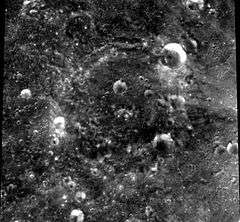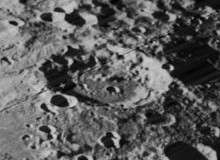Laue (crater)
Laue is a lunar impact crater that lies across the south-southwestern rim and interior floor of the huge walled plain Lorentz. This feature is located on the Moon's far side, just beyond the west-northwestern limb. Under conditions of favorable libration and illumination from the Sun, this area can be seen at a very oblique angle from the Earth.
 Clementine image | |
| Coordinates | 28.0°N 96.7°W |
|---|---|
| Diameter | 87 km |
| Depth | Unknown |
| Colongitude | 98° at sunrise |
| Eponym | Max von Laue |


This is a moderately worn crater formation with several small craters along the rim. The largest of these is a small crater that intrudes slightly into the northeastern rim. A cup-shaped crater lies along the east-southeastern inner wall. The interior wall is generally less wide along the northern side than elsewhere, which may have been the result of the terrain in which the impact was formed.
There is a pair of low central ridges offset just to the south of the crater midpoint. A small, cup-shaped crater lies within the interior floor to the north-northwest of the center. The remainder of the floor is relatively level, but is marked by a number of small craters.
Satellite craters
By convention these features are identified on lunar maps by placing the letter on the side of the crater midpoint that is closest to Laue.
| Laue | Latitude | Longitude | Diameter |
|---|---|---|---|
| G | 27.8° N | 93.2° W | 36 km |
| U | 28.8° N | 101.4° W | 56 km |
References
- Andersson, L. E.; Whitaker, E. A. (1982). NASA Catalogue of Lunar Nomenclature. NASA RP-1097.CS1 maint: ref=harv (link)
- Blue, Jennifer (July 25, 2007). "Gazetteer of Planetary Nomenclature". USGS. Retrieved 2007-08-05.CS1 maint: ref=harv (link)
- Bussey, B.; Spudis, P. (2004). The Clementine Atlas of the Moon. New York: Cambridge University Press. ISBN 978-0-521-81528-4.CS1 maint: ref=harv (link)
- Cocks, Elijah E.; Cocks, Josiah C. (1995). Who's Who on the Moon: A Biographical Dictionary of Lunar Nomenclature. Tudor Publishers. ISBN 978-0-936389-27-1.CS1 maint: ref=harv (link)
- McDowell, Jonathan (July 15, 2007). "Lunar Nomenclature". Jonathan's Space Report. Retrieved 2007-10-24.CS1 maint: ref=harv (link)
- Menzel, D. H.; Minnaert, M.; Levin, B.; Dollfus, A.; Bell, B. (1971). "Report on Lunar Nomenclature by the Working Group of Commission 17 of the IAU". Space Science Reviews. 12 (2): 136–186. Bibcode:1971SSRv...12..136M. doi:10.1007/BF00171763.CS1 maint: ref=harv (link)
- Moore, Patrick (2001). On the Moon. Sterling Publishing Co. ISBN 978-0-304-35469-6.CS1 maint: ref=harv (link)
- Price, Fred W. (1988). The Moon Observer's Handbook. Cambridge University Press. ISBN 978-0-521-33500-3.CS1 maint: ref=harv (link)
- Rükl, Antonín (1990). Atlas of the Moon. Kalmbach Books. ISBN 978-0-913135-17-4.CS1 maint: ref=harv (link)
- Webb, Rev. T. W. (1962). Celestial Objects for Common Telescopes (6th revised ed.). Dover. ISBN 978-0-486-20917-3.CS1 maint: ref=harv (link)
- Whitaker, Ewen A. (1999). Mapping and Naming the Moon. Cambridge University Press. ISBN 978-0-521-62248-6.CS1 maint: ref=harv (link)
- Wlasuk, Peter T. (2000). Observing the Moon. Springer. ISBN 978-1-85233-193-1.CS1 maint: ref=harv (link)